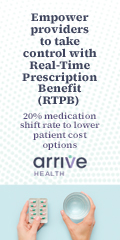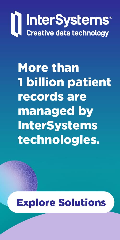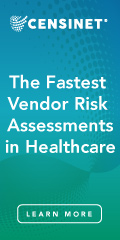HIStalk Interviews Kyle Kiser, CEO, Arrive Health
Kyle Kiser is CEO of Arrive Health.

Tell me about yourself and the company.
I’m in Year 10 with Arrive Health, having been around since the beginning as part of the original team. My background has primarily been in payer-facing digital health. I was an early employee at a couple of digital startups. Before that, Principal had an internal startup called Principal Wellness Company, which was a corporate wellness business, and I was a part of that. That’s probably where I caught the entrepreneurial bug, because it was this group of a few dozen people inside this tens of thousands of employees financial services business. We got to work on really interesting problems, work directly with customers, and move fast. There were some great leaders in that organization. That was the start of this interest and curiosity.
Arrive Health was previously known as RxRevu through mid-2022. Our founding story involves one of our co-founders, Dr. Kevin O ‘Brien, who is a physician in Denver. His mom came to him about her high out-of-pocket spend on meds. Like any son who has the capability to do so, he helped her. There were simple things that he could impact. Take this brand, break it into its generic parts. There’s a therapeutic alternative that you could use for this one that saves you money. Maybe one that you can pill split.
He made a pretty significant impact on her monthly out-of-pocket cost for those meds. That inspired him to start doing this work in his clinic. Kevin wasn’t doing that because he was in a value-based agreement. He wasn’t doing that because he made more money for doing it. He just started to identify the real need that the only meds that work are the ones you can afford. He started tracking these things over time for his patients. That is the seed of what became the initial API, which then became a real-time benefit network that connects into the point of care.
But it all started with Kevin wanting to help his mom. We have a mantra in the company, “Lucy Up.” That’s our way to say, raise your eyes to the mission and really remember why we’re here. Kevin’s mom’s name is Lucy. Everybody has somebody in their life, like Kevin did, who has had an experience with the healthcare system that’s too expensive, confusing, hard to navigate, or hard to access. That’s a very personal problem when it happens. We use Lucy Up as a mantra to make sure that we continue to take that problem personally. That has been a huge part of our story and what motivates everybody on our team.
From a business perspective, we offer a market-leading real-time benefit network. We connect to the point of care into the e-prescribing systems and the EHRs that are used by providers. We provide real-time, patient-specific, moment in time, specific insight into the cost of medications.
That has evolved since we last spoke. We’ve built some interesting prior authorization tools. We bought a company from UPMC that was doing some interesting work around medication management and adherence in concert with the health system access team. We expanded beyond just the point-of-care price transparency piece, which is still a huge focus and important primary part of what we’re doing, but it also enables lots of other opportunities to solve new affordability problems and to solve access issues around prior auth. We’re pursuing those things with all of our might right now.
When a patient leaves their physician visit knowing that their prescription has been sent off to their preferred pharmacy, what unpleasant surprises might await them at the pharmacy counter?
The key point is that the primary cause of non-adherence is cost. Patient cost is a lot more complicated problem to solve than it used to be. Deductibles used to be hundreds of dollars, but now they are multiple thousands of dollars. Out-of -pocket costs around drugs went from $5, $10, or $20 to hundreds and thousands of dollars and even more in some rare cases. The consequences of the wrong choice are much higher for patients.
At the same time, the complexity that physicians have to manage is way higher. Think about biosimilars, which have great promise. A lot of the health plans and PBMs are making specific choices around the right biosimilar, so now you’re going to end up in an environment where there’s a branded med, there’s a biosimilar option, or there are multiple biosimilar options to choose from, and those choices are different based on payer, PBM, or the type of insurance.
It used to be that if you talked to a provider, they probably knew that this drug makes the most sense for Blue Cross patients and this other one makes sense for these other patients. Now the complexity of that is not something that providers can manage in their head. It’s a problem that requires a piece of technology to help manage, because the complexity is so high and the consequences of a choice that is not aligned appropriately with the patient’s insurance, or when a cash pay option is more important, or when a patient may need some type of other support, means hundreds and thousands of dollars to the patient.
When half of Americans can’t endure an unexpected thousand-dollar expense, the stakes are pretty high. That’s the way we are thinking about the problem. The stakes are higher for the patients, the complexity is higher for the provider, and we have to show up with both the right connectivity and the right type of technology that brings to the table the intelligence of a pharmacist in real time to be able to meet that need.
Does the problem flare up on January 1 when patients might change insurance or plans, meaning that their maintenance meds might require a new prior authorization, coverage for the med might change, and their deductible resets?
A lot of changes happen around the first of the year. October 1 is another important moment with a lot of anniversaries for insurance. Changes in plan design make a big impact. Those happen on certain intervals, and those intervals create spikes in those types of changes. That’s only going to get more complicated as the Inflation Reduction Act impacts Medicare and the plan provisions inside of Medicare.
We are only making things more complicated. In some cases, with good intent, not complicated for the sake of complicated. We’re trying to solve problems and there are only so many levers to do it, but it makes the job of the prescriber much harder, which is what we are focused on. How we clear the path for that provider to make a clinical choice that makes sense and focus on the clinical visit with that patient. Try to take the burden of this background web of complexity out of that equation, to the extent that we can, and just serve up what makes sense based on what we can see in our system.
You mentioned biosimilars, which hold promise to reduce the costs of big-ticket drugs such as Humira. Uptake seems to have been slow, maybe because the doctor needs to generate a new prescription since it’s not a simple generic substitution. What lessons has this process offered?
The lesson is that things really do take some time to work their way through the system. The primary regulatable insurance types, like Medicare, can be impacted broadly by a regulatory choice. Commercial insurance is an entirely different animal, and much of that is self-funded employers. That change has to be adopted employer by employer by employer by employer by employer. The web of decision-making there is that brokers and consultants are involved, the health plan is involved, and there’s the plan sponsor themselves. There’s a lot of different decision makers along that chain, so it takes a while for things to work their way through the system. That’s one thing, and then once they do work their way through the system, we have to communicate that to providers and care teams so that they can help guide patients through that newly formed maze.
Will 21st Century Cures and broader interoperability help with payer-provider-patient communication?
It’s a mix. There are some great success stories, with real-time benefit among them. We benefited from a CMS rule that caused some great adoption of real-time benefit technologies on the health plan and health IT side. That’s a good news story about positive impact.
There’s still a bit of adoption happening around Cures, but it not going to happen in abstract. The distinction is that real-time benefit had a discrete use case with a problem to solve. Docs want to know how much things cost and they want to do that so they can help patients. We could move into that space, which requires interoperability and requires providers, health plans, and technology companies working more closely together. That works well. The things that are important, infrastructure like Cures to change the way we operate, require useful use cases to then drive them forward.
Some of the prior authorization rules are good momentum in that direction. That’s where everybody stands to benefit from doing that better and differently. It costs health plans a ton of money to administer prior auths, but at the same time, they feel like they can’t really reduce the complexity of prior auth because it’s an important tool for them. Providers and patients bear the burden of how challenging that can be. They’re the ones completing the prior auth, reworking medication choices, and from a patient perspective, trying to figure out what’s going on. It’s one of those things where prior auth is a powerful use case to drive forward some of the interoperability ambition in a discrete use case that will benefit everybody.
What’s the balance between insurers using PA to reduce their costs while requiring clinicians to perform free work to send them PA documentation? Could that be done electronically, or will AI play a role and perhaps even result in the AI systems of both parties arguing with each other?
That seems to be happening now. The AI systems that are pitted against each other is probably current state in some cases. PA is definitely one of those universal things that everybody agrees needs to be different.
AI is a great opportunity to make that different. There will be a role for payers, EMRs, and providers to operate differently together. Doing things like indexing the clinical data in a form that allows you to autocomplete prior auth is a no-brainer. It should happen, it is happening, and I think it will be adopted quickly.
One of the things that we are focused on, which is a little bit different than that, is how to take some of those policies and turn them into decision support. Every prior auth has documentation associated, where the health plan says, “Here are the rules of the road” for prescribing whatever it is you want to prescribe. This is probably not totally fair, but my guess is that the last person who read that policy is the one who wrote it.
The way the world works today is that providers submit everything and see what happens. They’ve been trained to do that, because the decision-making seems invisible to them. We want to turn that policy into decision support. We integrate directly into decision-making workflows so that we can start much in the same way that we did with real-time benefit. Let’s get the answer right the first time and guide that to the appropriate path based on the criteria that the payer requires, because then patients are more adherent.
I’ve heard estimates that one-third of patients just walk away when they experience a prior auth. That’s not great. We’re going to do this in a way that’s less burdensome to the provider and less consequential to the patient.
We’re going to reduce the waste that is associated with the payer experience. They probably have to deny a majority of what’s submitted, which we can avoid if we get that criteria into the hands of the decision maker. That’s where we’re focused and that’s what I’m most excited about, because if we do that right, a system embedded in the EMR that’s a guidance system could be a scenario where prior auths are no longer required. If we can get adoption of that type of tool at a broad scale the way we have with real-time benefit, we can go to those payers and say, not only are they following these guidelines, they’re using this tool to do so, it’s auditable, and we can show you. Then we can start to ask for a gold carding scenario, where prescribers maybe won’t be subjected to prior auth because they are using these types of tools.
That’s where I want to go, because PA is one of those things that we all assume has always been a part of American healthcare. The first PAs were not even introduced until the late 1990s, maybe mid 1990s. It has not always been this way. It doesn’t have to always be this way. We just need the tools to behave differently, and that’s where we’re focused.
Big corporations operate drug stores, specialty pharmacies, health insurance plans, pharmacy benefit managers, and in the case of UnitedHealth Group, all of the above. Can technology improve transparency in a system that was built around the profit motive and vertical integration?
There’s still a lot of really good and important problems to solve for patients in the existing system and in the existing structure. The profit motive certainly informs a desire to build bigger organizations, more consolidated organizations. But at a plan sponsor level, they are still incentivized to try to control cost and get the best quality care at lowest cost. There’s plenty of room to run on making the experience better, on creating more consumer choice.
We’re seeing a ton of progress there on driving more consumer choice at the point of care and throughout the patient experience. There’s more acceptance of just “that’s the way that is.” Some of those things are not necessarily our business so this is me commenting on industry generally. There’s things like integrated cash card programs that are being adopted by some of those people that you’ve mentioned that take insurance benefits and cash pay and start to compare those things, which is kind of the way it should work.
Like inside the deductible, you’re more often than not having to pay out of pocket. The in-network negotiated price list was intended to do a calculation to come up with a co-insurance number, not intended as the cash price. That has created the opportunity for these cash card programs and discount card programs. The integration of the benefit design and cash options is happening. Some of the regulations that relieve the restrictions that some pharmacies have on guiding on that have been helpful.
There’s plenty of plenty of places to make progress. If I were president of the universe today and could make the consolidation different, would I? Maybe. But we have to stand to where we are and make progress in the environment in which we exist. There’s lots of problems to solve for patients and plan sponsors in today’s environment.
What is the company’s strategy for the next few years?
A lot of it is the prior auth story we were just talking about. There’s a ton of opportunity to take on that space in a new way. That can also be working closely with some of the incumbents.
Prior auth is a big part of the future strategy,and expanding our definition of affordability is how I would also characterize our other strategic focus. How do we make sure that we’re getting best price for patients? That might be alternative ways to pay, that might be pharmacy selection, that might be guidance within the plan design. All of those things are relevant.
It’s about that type of consumer choice at the point of care and throughout the patient experience. That’s a huge part of our future. In the three- to five-year time horizon, we’ve been in a point of care connected price transparency environment, a real-time benefit environment. We are moving to a point of care care team integrated environment. That’s a lot of the work that we’re doing today. Where I want it to go is a consumer-facing type of experience and enabling that experience to happen.
An empowered consumer will make a huge difference. Over the last 20 years, e-prescribing actually reduced consumer choice. That’s the only time I can think of where we adopted a technology and the flexibility to choose and understand choice went down. You went from being able to take your paper prescription wherever you wanted to to being constrained by an e-prescribing system that just tells you to go to a pharmacy, then find out what it is when you get there. I want to help evolve our industry to be fully invested in empowering consumers in that process again. The technology is there.
The promise of things like LLMs and generative AI enable that even further, and to your point around interoperability, the framework that is required to accomplish that is in place. It’s really just about starting to execute on that.
Providers are important stewards. We will always be focused on that patient-provider relationship because it’s the most important leverage point for positive change. We have to continue to expand that to empower consumers to make choices around some of the things I’ve mentioned — how to navigate plan design, how to choose pharmacies, and how to understand their alternatives as it relates to payment. Those are all the places that we’re going.



















































































Many of them had to hit the road again after Spotify torched their retirement plans. Their concerts are shortened, lower-octave…